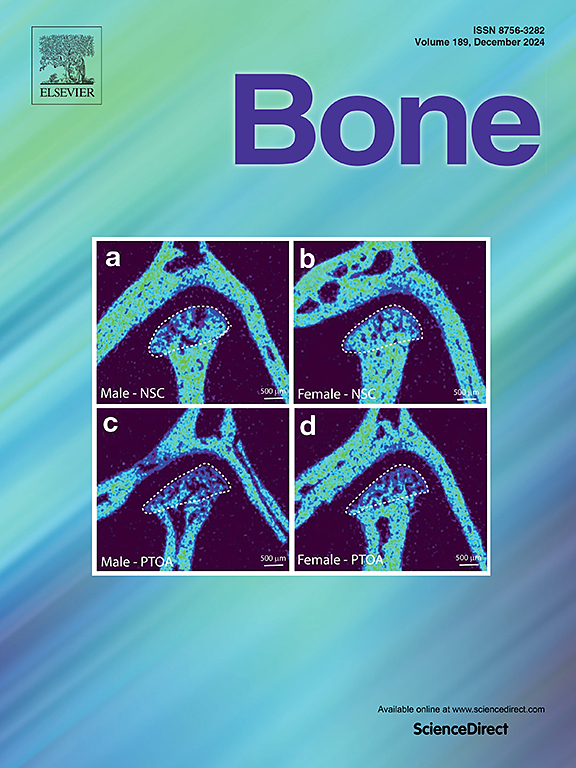What personal factors are associated with osteoporosis, fragility fracture, and osteopenia? A population-level analysis using the United Kingdom Biobank
IF 3.6
2区 医学
Q2 ENDOCRINOLOGY & METABOLISM
引用次数: 0
Abstract
Purpose
Osteopenia, osteoporosis, and fragility fractures pose a major public health concern. Population-level clinical and biopsychosocial data may uncover modifiable risk factors to target when developing whole person approaches to managing these conditions. The purpose of this study was to identify personal risk factors associated with osteoporosis, fragility fractures, and osteopenia from the United Kingdom Biobank (UKB) – a large population-level database.
Methods
We performed a cross-sectional study using the UKB to evaluate the association between 39 systematically selected explanatory variables with a diagnosis of osteopenia, osteoporosis, or fragility fracture. Bivariate analysis was performed followed by multivariable logistic regression adjusting for multicollinearity using covariance testing.
Results
Of 502,507 patients in the UKB, 40,657 had complete bone mineral density information from DEXA scans, and 32,193 had sustained a fragility fracture in the previous five years. In multivariable regression, increased time spent watching television (OR 1.15), living in an area with a high index of deprivation (OR 1.14), infrequent visits from friends and family (OR 1.09), experiencing symptoms of anxiety (OR 1.09), experiencing symptoms of depression (OR 1.08), and decreased exercise frequency (OR 1.03), were associated with increased risk of osteoporosis. Decreased exercise frequency (OR 1.27), increased BMI (OR 1.2), living in an area with a high index of deprivation (OR 1.11), and decreased salary (OR 1.10) were associated with increased risk of fragility fracture. Symptoms of anxiety (OR 1.15), living in an area with a high index of deprivation (OR 1.13), and increased time spent watching television (OR 1.11), living alone (OR 1.08), and symptoms of depression (OR 1.06), were associated with increased risk of osteopenia (p < 0.05 for all variables).
Conclusion
Analysis of population-level datasets reveal a range of modifiable mental, social, and lifestyle/behavioral health factors that can inform multidisciplinary team-based care, including strategies that respond to psychosocial concerns and sustaining healthy lifestyles and behaviors in patients experiencing osteoporosis, fragility fracture, and osteopenia. Future work should assess the impact of integrated, whole person management programs for these conditions on longitudinal outcomes.
哪些个人因素与骨质疏松症、脆性骨折和骨质疏松有关?利用英国生物数据库进行的人群分析。
目的:骨质疏松、骨质疏松症和脆性骨折是一个重大的公共卫生问题。人群层面的临床和生物心理社会数据可能会发现可改变的风险因素,从而在制定全人管理这些疾病的方法时将其作为目标。本研究旨在从英国生物库(UKB)--一个大型人口级数据库--中找出与骨质疏松症、脆性骨折和骨质疏松症相关的个人风险因素:我们利用英国生物库进行了一项横断面研究,评估了 39 个系统选择的解释变量与骨质疏松症、骨质疏松症或脆性骨折诊断之间的关联。在进行双变量分析后,我们又进行了多变量逻辑回归,并通过协方差检验对多重共线性进行了调整:在英国骨质疏松症研究所的 502,507 名患者中,40,657 人通过 DEXA 扫描获得了完整的骨密度信息,32,193 人在过去五年中发生过脆性骨折。在多变量回归中,看电视时间增加(OR 1.15)、居住在贫困指数较高的地区(OR 1.14)、不经常拜访亲友(OR 1.09)、出现焦虑症状(OR 1.09)、出现抑郁症状(OR 1.08)和运动频率减少(OR 1.03)与骨质疏松症风险增加有关。运动频率减少(OR 1.27)、体重指数增加(OR 1.2)、居住在贫困指数较高的地区(OR 1.11)和工资减少(OR 1.10)与脆性骨折风险增加有关。焦虑症状(OR 1.15)、生活在贫困指数高的地区(OR 1.13)、看电视时间增加(OR 1.11)、独居(OR 1.08)和抑郁症状(OR 1.06)与骨质疏松风险增加有关(P 结论:对人口层面的数据集进行分析后发现,骨质疏松风险增加与生活在贫困指数高的地区(OR 1.13)、看电视时间增加(OR 1.11)、独居(OR 1.08)和抑郁症状(OR 1.06)有关:对人群数据集的分析表明,一系列可改变的精神、社会和生活方式/行为健康因素可为多学科团队护理提供信息,包括应对社会心理问题的策略以及维持骨质疏松症、脆性骨折和骨质疏松症患者的健康生活方式和行为。未来的工作应评估针对这些病症的综合全人管理计划对纵向结果的影响。
本文章由计算机程序翻译,如有差异,请以英文原文为准。
求助全文
约1分钟内获得全文
求助全文
来源期刊

Bone
医学-内分泌学与代谢
CiteScore
8.90
自引率
4.90%
发文量
264
审稿时长
30 days
期刊介绍:
BONE is an interdisciplinary forum for the rapid publication of original articles and reviews on basic, translational, and clinical aspects of bone and mineral metabolism. The Journal also encourages submissions related to interactions of bone with other organ systems, including cartilage, endocrine, muscle, fat, neural, vascular, gastrointestinal, hematopoietic, and immune systems. Particular attention is placed on the application of experimental studies to clinical practice.
 求助内容:
求助内容: 应助结果提醒方式:
应助结果提醒方式:


